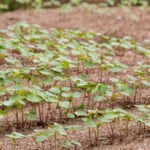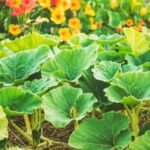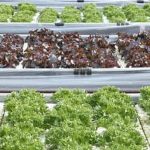When it comes to maintaining a healthy and thriving vegetable garden, finding effective and safe methods to control pests and improve soil health is essential. One widely talked about solution is diatomaceous earth. But what exactly is diatomaceous earth, and is it safe for use in vegetable gardens?
Diatomaceous earth, often abbreviated as DE, is a naturally occurring sedimentary rock made up of the fossilized remains of tiny aquatic organisms known as diatoms. These microscopic organisms have hard shells primarily composed of silica, making diatomaceous earth rich in this mineral. The unique structure of diatoms creates a fine powder-like substance with excellent absorbent properties.
In gardening, diatomaceous earth is commonly used as an organic pest control method and soil amendment due to its ability to deter insects and improve drainage. This powdery substance acts as a physical barrier to pests by dehydrating their bodies and disrupting their outer protective layer. Additionally, it can help break up compacted soil, enhance water retention, and provide beneficial minerals like silicon.
Understanding the basics of diatomaceous earth sets the stage for exploring its benefits in vegetable gardens, potential safety concerns, proper application techniques, environmental impact, and more. By gaining knowledge about this natural gardening tool, you can make informed decisions on how to effectively utilize it while keeping your vegetable garden healthy and safe for consumption.
Benefits of Using Diatomaceous Earth in Vegetable Gardens
Diatomaceous earth offers numerous benefits when used in vegetable gardens. Understanding these advantages can help gardeners make informed decisions about whether to incorporate this natural substance into their gardening practices.
Pest Control and Prevention
One of the main benefits of using diatomaceous earth in vegetable gardens is its ability to effectively control and prevent pests and insects. Diatomaceous earth works by dehydrating the exoskeletons of pests, ultimately killing them.
This mechanism makes it an excellent alternative to chemical pesticides, as it provides a non-toxic solution for pest management. Additionally, diatomaceous earth is not selective in which pests it affects, making it effective against a wide range of common garden pests such as aphids, slugs, beetles, and caterpillars.
Improved Soil Health and Drainage
Another advantage of using diatomaceous earth in vegetable gardens is its ability to improve soil health and drainage. Diatomaceous earth is composed of microscopic fossilized algae called diatoms that have a high silica content. When incorporated into the soil, diatomaceous earth helps increase soil porosity and improves water absorption capabilities. This can be especially beneficial for dense or compacted soils that drain poorly.
Moreover, diatomaceous earth acts as a natural soil conditioner by enhancing nutrient availability for plants. Its high silica content also helps strengthen plant cell walls, leading to increased resistance against diseases and stronger root systems.
Environmentally Friendly
Using diatomaceous earth as a natural pest control method in vegetable gardens can contribute to more environmentally friendly gardening practices. Unlike synthetic chemical pesticides that can harm beneficial insects and pollinators, diatomaceous earth has minimal impact on these beneficial organisms when used correctly.
Bees, ladybugs, and other important pollinators are not affected by contact with diatomaceous earth since they do not have exoskeletons. This allows gardeners to protect their vegetable plants from pests while still maintaining a healthy ecosystem in their gardens.
Furthermore, diatomaceous earth is biodegradable and does not persist in the environment. Over time, it breaks down into its natural components, leaving no harmful residue behind. This makes it a sustainable option for long-term pest management in vegetable gardens.
In summary, using diatomaceous earth in vegetable gardens provides multiple benefits. It offers effective pest control, improves soil health and drainage, and supports environmentally friendly gardening practices. By incorporating diatomaceous earth into their gardening routine, vegetable gardeners can enjoy healthier plants without relying on harsh chemicals or synthetic pesticides.
Safety Concerns
Diatomaceous earth is a popular choice for pest control in vegetable gardens due to its natural properties and effectiveness. However, concerns about the safety of diatomaceous earth on humans often arise. In this section, we will address those concerns and debunk common myths surrounding the use of diatomaceous earth.
Firstly, it’s important to understand the difference between food-grade and non-food-grade diatomaceous earth. Food-grade diatomaceous earth is specifically labeled as safe for consumption by humans and animals. It undergoes a purification process to remove any impurities or harmful substances. Non-food-grade diatomaceous earth, on the other hand, is primarily used for industrial purposes and should not be ingested.
There are strict guidelines regulated by the FDA (Food and Drug Administration) regarding the use of diatomaceous earth in food crops. When applied correctly, food-grade diatomaceous earth poses no significant health risks to humans. It is crucial to follow recommended dosage instructions and ensure thorough washing of vegetables before consuming them. Proper application minimizes ingestion risks and provides an additional layer of safety.
To further clarify potential risks associated with improper handling or ingestion of any form of diatomaceous earth, it’s worth noting that inhaling excessive amounts of fine dust particles can irritate the respiratory system. Therefore, when applying diatomaceous earth in your vegetable garden or handling it directly, it is advisable to wear protective gear such as gloves, goggles, and a mask to prevent inhalation.
Safe Application of Diatomaceous Earth in Vegetable Gardens
Step-by-step guide on how to safely apply diatomaceous earth in vegetable gardens
When it comes to using diatomaceous earth in vegetable gardens, proper application is key to ensure both effectiveness and safety. Here is a step-by-step guide on how to apply diatomaceous earth safely:
- Identify the problem areas: Before applying diatomaceous earth, identify the specific areas in your vegetable garden that are most affected by pests or insects. This will help you target those areas more efficiently.
- Choose the right product: Make sure to use food-grade diatomaceous earth for your vegetable garden. Food-grade diatomaceous earth is safe for humans, animals, and the environment.
- Wear protective gear: When handling diatomaceous earth, it’s important to protect yourself by wearing gloves, goggles, and a dust mask. This will prevent any potential irritation or respiratory issues.
- Apply evenly: Sprinkle a thin layer of diatomaceous earth around the base of your plants or directly onto the foliage if necessary. Be sure to cover both the upper and lower surfaces of leaves where pests tend to hide.
- Reapply as needed: Depending on the severity of pest infestation, you may need to reapply diatomaceous earth every few days or weeks. Monitor your plants regularly and continue application until the issue is resolved.
Tips on proper protective gear and handling precautions for optimum safety
To ensure optimum safety while working with diatomaceous earth in your vegetable garden, here are some essential tips on protective gear and handling precautions:
- Gloves: Wear waterproof gloves when handling diatomaceous earth to protect your skin from irritation and dryness.
- Goggles: Protect your eyes by wearing safety goggles or glasses while applying diatomaceous earth. This will prevent any particles from getting into your eyes and causing discomfort.
- Dust mask: Use a dust mask or respirator to avoid inhaling any fine dust particles that may be present in diatomaceous earth. This is especially important if you have respiratory conditions or sensitivities.
- Proper storage: When not in use, store your diatomaceous earth in a cool, dry place away from direct sunlight. This will help maintain its potency and prevent clumping.
- Avoid windy conditions: Apply diatomaceous earth on a calm day when there is little to no wind. This will prevent the dust from blowing around and potentially causing irritation to yourself or others nearby.
Recommended dosage and intervals for applying diatomaceous earth in different situations
The dosage and application intervals of diatomaceous earth can vary depending on the severity of the pest problem and the specific vegetables you are growing. Here are some general guidelines:
- Light infestations: For light infestations, apply a thin layer of diatomaceous earth around the base of plants or directly onto foliage every 7-14 days. Monitor the situation closely and adjust as needed.
- Heavy infestations: In cases of heavy infestations, you may need to apply diatomaceous earth more frequently, every 3-7 days. Be sure to reapply after rainfall as it may wash away the powder.
- Preemptive measures: If your vegetable garden is prone to certain pests or insects, consider applying a preventative layer of diatomaceous earth early in the season before any signs of infestation appear.
Remember to always follow label instructions provided by the manufacturer for specific dosages and application recommendations based on your individual needs and circumstances.
Potential Risks to Vegetable Plants
While diatomaceous earth is generally considered safe for use in vegetable gardens, there are some potential risks and negative effects that gardeners should be aware of. One of the main concerns is that diatomaceous earth may be too abrasive for certain vegetable plants, especially those with delicate foliage or young seedlings. The sharp edges of the silica particles can cause damage and tearing to the leaves, leading to stunted growth or even plant death.
Certain vegetable varieties may also be more sensitive to diatomaceous earth than others. For example, leafy greens such as lettuce and spinach have more fragile leaves that are more prone to damage. Additionally, young plants that are still developing may be more susceptible to injury from diatomaceous earth than mature ones. It is important for gardeners to carefully observe their plants and monitor for any signs of distress or adverse effects after applying diatomaceous earth.
If you have sensitive plants in your vegetable garden, there are alternative organic pest control methods that can be used instead of diatomaceous earth. These include companion planting, using insect-repelling herbs such as basil or marigold, or utilizing biological controls such as beneficial insects like ladybugs or praying mantises. It is always a good idea to conduct research on the specific needs and sensitivities of your vegetable plants before applying any pest control methods.
Environmental Impact of Diatomaceous Earth in Vegetable Gardens
Diatomaceous earth, a natural and organic substance, can have an impact on the environment when used in vegetable gardens. Understanding the ecological implications of this gardening tool is crucial for maintaining a balanced ecosystem and promoting sustainable practices.
Compatibility with Beneficial Insects and Pollinators
One of the main concerns regarding the use of diatomaceous earth is its potential impact on beneficial insects and pollinators. While diatomaceous earth can be effective against pests and insects, it is important to consider its compatibility with beneficial organisms such as ladybugs, lacewings, bees, and butterflies.
Fortunately, when used correctly, diatomaceous earth primarily affects crawling insects rather than flying ones. Its mechanical action works by abrading the exoskeleton of pests like slugs, snails, ants, and aphids. However, beneficial insects that may come into contact with diatomaceous earth could also be affected if they crawl through treated areas. To minimize harm to these important creatures:
- Apply diatomaceous earth primarily in areas where crawling insects are problematic.
- Avoid applying it directly to flowers or other areas frequented by pollinators.
- Consider using alternative organic pest control methods that specifically target problem pests while sparing beneficial insects.
Breakdown and Degradation in the Environment
Another aspect to consider is how diatomaceous earth breaks down and degrades in the environment over time. Diatom skeletons consist mainly of silica, a natural mineral that does not decompose easily. As a result, once applied in the garden, diatomaceous earth persists for an extended period before eventually becoming part of the soil composition.
- Diatomaceous earth remains effective against pests until it becomes wet or damp.
- Rainfall or irrigation can reduce its effectiveness, requiring reapplication if necessary.
- As diatomaceous earth naturally breaks down over time, it will become incorporated into the soil, contributing to soil health and structure.
Promoting Ecological Balance
To ensure a sustainable gardening practice, it is important to strive for an ecological balance in vegetable gardens. This can be achieved by using diatomaceous earth judiciously and in conjunction with other organic gardening methods that promote biodiversity.
- Implement companion planting strategies to attract beneficial insects and deter pests naturally.
- Create diverse habitats within the garden area by incorporating native plants and providing shelter for beneficial organisms.
- Maintain healthy soil through proper composting, organic fertilizers, and regular soil testing to minimize the need for excessive pesticide use.
By adopting an integrated pest management approach and considering the environmental impact of diatomaceous earth, vegetable gardeners can strike a balance between effective pest control measures and maintaining a thriving ecosystem.
Including this section in the article helps provide a comprehensive understanding of how diatomaceous earth affects the environment in vegetable gardens. It emphasizes the importance of responsible application and encourages readers to consider alternative organic pest control methods that mitigate potential harm to beneficial insects and pollinators. Additionally, it underlines the role of diatomaceous earth in improving soil health while emphasizing the need for ecological balance through sustainable gardening practices.
Is Diatomaceous Earth Safe for Consuming Vegetables?
Consuming vegetables that have been grown with the use of diatomaceous earth is a common concern among gardeners. The safety of diatomaceous earth in food crops is an important consideration when using this pest control method in vegetable gardens. In order to address this concern, it is essential to examine FDA regulations and guidelines regarding the use of diatomaceous earth in food production.
The Food and Drug Administration (FDA) has classified diatomaceous earth as Generally Recognized as Safe (GRAS) when used as a pesticide. This means that it is considered safe for consumption when applied according to approved guidelines. However, it is crucial to understand that not all forms of diatomaceous earth are suitable for use on food crops.
There are two main types of diatomaceous earth: food-grade and non-food-grade. Food-grade diatomaceous earth is specifically processed and treated to meet higher purity standards, making it safe for use on edible plants. This type of diatomaceous earth contains less than 1% crystalline silica, which is the component responsible for potential health risks.
On the other hand, non-food-grade diatomaceous earth may contain larger amounts of crystalline silica, making it unsuitable for use on vegetables or other edible plants. It is important to strictly adhere to the recommended usage guidelines and choose only food-grade diatomaceous earth when applying it in vegetable gardens.
To minimize ingestion risks, it is also crucial to practice proper washing techniques before consuming vegetables grown with the use of diatomaceous earth. Thoroughly rinsing produce under running water can help remove any remaining traces of diatomaceous earth particles. Additionally, following recommended waiting periods between application and harvest can help ensure that any residual powder has dissipated.
In summary, when used appropriately and with proper precautions, including choosing food-grade diatomaceous earth and practicing thorough washing techniques, consuming vegetables grown with the use of diatomaceous earth is considered safe. It is always advisable to consult with local agricultural authorities or extension offices for specific recommendations and guidelines regarding the use of diatomaceous earth in food crops.
Personal Experiences and Testimonials
Many gardeners have reported positive experiences and success with using diatomaceous earth in their vegetable gardens. These personal anecdotes and testimonials highlight the benefits of diatomaceous earth as an effective natural pest control method.
One gardener, Sarah, shared her experience using diatomaceous earth to control a persistent aphid infestation on her tomato plants. She noticed that after applying a thin layer of diatomaceous earth around the base of the plants, the aphids were significantly reduced in number. Over time, her tomato plants thrived and produced healthy, pest-free fruits.
Another gardener, Robert, praised diatomaceous earth for its ability to prevent root rot in his vegetable garden. He had struggled with poor soil drainage in his raised beds but found that adding diatomaceous earth to the soil improved its structure and increased water absorption. As a result, his vegetables grew stronger and healthier.
Experts in organic gardening also recommend diatomaceous earth for its effectiveness against various garden pests. Dr. Emily Carter, a renowned horticulturist, advocates for its use as a safe alternative to chemical pesticides. She emphasizes that when applied correctly, diatomaceous earth poses minimal risks to both plants and humans while effectively controlling pests.
Overall, these personal experiences and testimonials demonstrate the efficacy of diatomaceous earth in vegetable gardens. However, it is important to note that results may vary depending on individual gardening practices and environmental factors.
| Gardener | Testimonial |
|---|---|
| Sarah | “I was amazed at how quickly diatomaceous earth controlled the aphids on my tomato plants. It’s like they disappeared overnight.” |
| Robert | “Diatomaceous earth saved my vegetables from root rot. It helped improve the drainage in my raised beds, and my plants have never been healthier.” |
| Dr. Emily Carter | “I highly recommend using diatomaceous earth as a safe and effective pest control method in vegetable gardens. It’s a great alternative to chemical pesticides.” |
Conclusion
In conclusion, diatomaceous earth is a safe and effective tool for maintaining a healthy vegetable garden when used properly. Throughout this article, we have explored the definition and uses of diatomaceous earth in gardening, as well as its numerous benefits for vegetable gardens. We have addressed safety concerns regarding human exposure to diatomaceous earth, clarifying the difference between food-grade and non-food-grade varieties.
By following proper application techniques, such as wearing protective gear and adhering to recommended dosage and intervals, users can minimize any potential risks associated with diatomaceous earth. Additionally, it is important to consider the potential risks to certain vegetable plants that may be more sensitive to the substance. However, alternative organic pest control methods are available for those with sensitive plants.
It is also crucial to consider the environmental impact of using diatomaceous earth in vegetable gardens. Overall, it has been found to be compatible with beneficial insects and pollinators while breaking down naturally over time in the environment.
When it comes to consuming vegetables grown with the use of diatomaceous earth, thorough washing and proper application can help minimize any potential risks. It is important for readers to make informed decisions based on personal circumstances and consult with local agricultural authorities if unsure about specific guidelines or regulations.
Frequently Asked Questions
Can you eat vegetables treated with diatomaceous earth?
Yes, you can eat vegetables that have been treated with diatomaceous earth. Diatomaceous earth is a natural and non-toxic substance that is commonly used to control pests in gardens and crops. It is made from the fossilized remains of small aquatic organisms called diatoms, which are rich in silica.
When diatomaceous earth is applied to vegetables, it works by physically damaging the exoskeleton of insects and pests, leading to dehydration and eventually death. Since it does not contain any harmful chemicals, it does not pose a health risk when consumed.
How do you use diatomaceous earth in a vegetable garden?
To use diatomaceous earth in a vegetable garden, it is important to first identify any pest infestations or potential issues with insects. Once identified, you can apply diatomaceous earth by lightly dusting it on the surfaces of the plants using a duster or by sprinkling it around the base of the plants. It is best to apply diatomaceous earth when the leaves are dry as this helps it adhere better to the plant surface.
It’s recommended to reapply after rain or watering as moisture reduces its effectiveness. It’s important to avoid excessive application and only use a thin layer as too much can create a barrier that may prevent water absorption.
Is diatomaceous earth safe for tomato plants?
Yes, diatomaceous earth is generally safe for tomato plants when used correctly. Tomato plants are susceptible to various pests such as aphids, slugs, snails, and caterpillars, among others. Diatomaceous earth can help control these pests without harming the tomatoes themselves.
The fine particles of diatomaceous earth cause tiny cuts on the exoskeleton of insects that come into contact with it, leading to dehydration and death of the pests while posing minimal risk to tomato plants. However, care should be taken when applying diatomaceous earth near tomato blossoms as excessive dusting may interfere with pollination by beneficial insects like bees.

If you’re looking to get into vegetable gardening, or are just looking for some tips on how to make your current garden better, then you’ve come to the right place! My name is Ethel and I have been gardening for years. In this blog, I’m going to share with you some of my best tips on how to create a successful vegetable garden.





